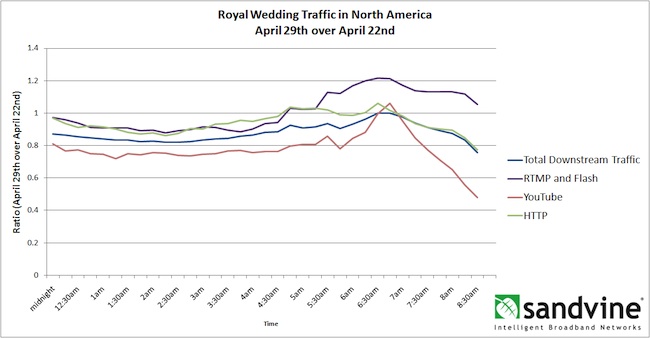Royal Wedding Stream Viewership Bodes Well for Flash Mobile, RTMP
Last week's royal wedding brought more than just a surprise the growing number of oddly shaped hats. On the heels of an event that shattered television viewership and live streaming records, pegged at almost 2 billion viewers for television and hundreds of millions for streaming, comes news that Adobe Flash's venerable RTMP streaming protocol may not be dead yet.
There are varying numbers in terms of viewership online, but the consistency of reports that internal streaming records were broken is indisputable: Akamai, the BBC, Google, and Livestream all say the royal wedding is now the highest-watched live stream, dwarfing the 160 million live stream views from the 2010 World Cup coverage.
RTMP Traffic Jumped During Royal Wedding
A more interesting note for Flash lovers and haters, though, is the report from Sandvine that Adobe's Flash RTMP live streaming protocol saw a significant jump in use during the royal wedding coverage.
In North America, Sandvine says that RTMP traffic grew almost 100% over normal levels in the U.S. and Canadian markets, as shown in the image below.

While it could certainly be argued that RTMP growth for this event was a number of viewers who were watching on their desktop machines at 1 a.m. PDT or 4 a.m. EDT, I suggest it might be something else that's driving RTMP traffic: the number of smartphones that use mobile Flash Player.
I may be more highly attuned to this fact, given the fact that I've spent the past week doing a number of mobile Flash Player 10.2 performance and battery impact tests, as a follow-on to the Adobe-sponsored Android-Flash Player 10.1 report that Transitions released back in February.
Flash on Android: A Growth Business
Yet, I think the trend can be spotted without the need to test five Android-based handsets—including the sweet Motorola Atrix phone—and a Xoom tablet. RTMP's growth can easily be tied to the surge in Android-based devices, many of which provide a consistent media consumption experience through the Flash Player (or AIR, as I found during this week's testing).
Consider a few facts.
First, the fact that Flash Player for the Android OS is, according to Adobe, "rated one of the top five free applications in the Android Market" and has more than 7.5 million downloads. That number is in addition to the number of devices that now come with Flash Player already built in to the device.
Second, while Adobe doesn't break down the number for Flash Player on mobile devices versus other consumer electronic (CE) devices, the company does say that the combination of CE and mobile devices supported by the end of 2010 accounted for more than 20 million devices.
Third, Adobe claims that, by the end of 2011, there will be Flash Player support on 132 million devices worldwide—a key factor given Android's rapid growth in the developing world.
Android and RTMP: A Royal Match?
What about smartphone growth closer to home? Recent statistics within the U.S. smartphone market also seem to bear out the fact that RTMP played from mobile devices could easily be driving the resurgence in RTMP.
ComScore keeps a rolling average of smartphone ownership in the United States, and it claims that smartphone ownership grew 13% from December 2010-February 2011, for a total ownership of 69.5 million smartphones in the US.
On top of that, Google's Android is now firmly in the lead with 33% of U.S. market share, or 23.1 million smartphones, having gained 7% market share in the same three-month period in which smartphone ownership grew 13% overall. In other words, more than half of smartphones purchased in that three-month period were powered by an Android operating system.
Apple also gained market share, with a 0.2% gain to end at 25.2% of total U.S. smartphone market share, or 17.5 million iPhones sold. RIM remained strong, with 28.9% market share or 20.1 million smartphones, although its overall percentage of market share slipped 4.9% at the expense of both Android OS- and Apple iOS-powered handsets.
Finally, no discussion of Android penetration would be complete without a discussion of tablets. While comScore didn't present market share for tablets in the above stats, Apple still commands a near-monopoly on the market.
Recently released Android "Honeycomb" tablet devices such as the Motorola Xoom and Samsung Galaxy Tab are still new enough to have limited impact on overall market share percentages, yet Adobe is again claiming that it will have joint Flash Player and AIR support on over 50 tablet devices by the end of 2011.
So what are we in the streaming industry to make of the resurgence of RTMP? That's a topic I'm exploring in more detail as Transitions wraps up testing of Flash Player 10.2 and AIR 2.6, just in time for the Google IO conference held next week, but it's a safe bet that RTMP will continue to remain valid as long as the Android OS continues its rapid growth, as Flash Player presents the most consistent media consumption experience on Android handsets and tablets.
Related Articles
Surprising the industry, Adobe has thrown in the towel on the Flash Player web browser plug-in for mobile devices. Read Jan Ozer's commentary on what this means for the future of Web development.
09 Nov 2011
When William and Kate tie the knot on Friday, many will view the event on their browsers. Here are online and even mobile options for seeing the ceremony.
25 Apr 2011
Think the Flash Player is a battery-drainer on mobile devices? Not so fast, says a new report.
16 Feb 2011